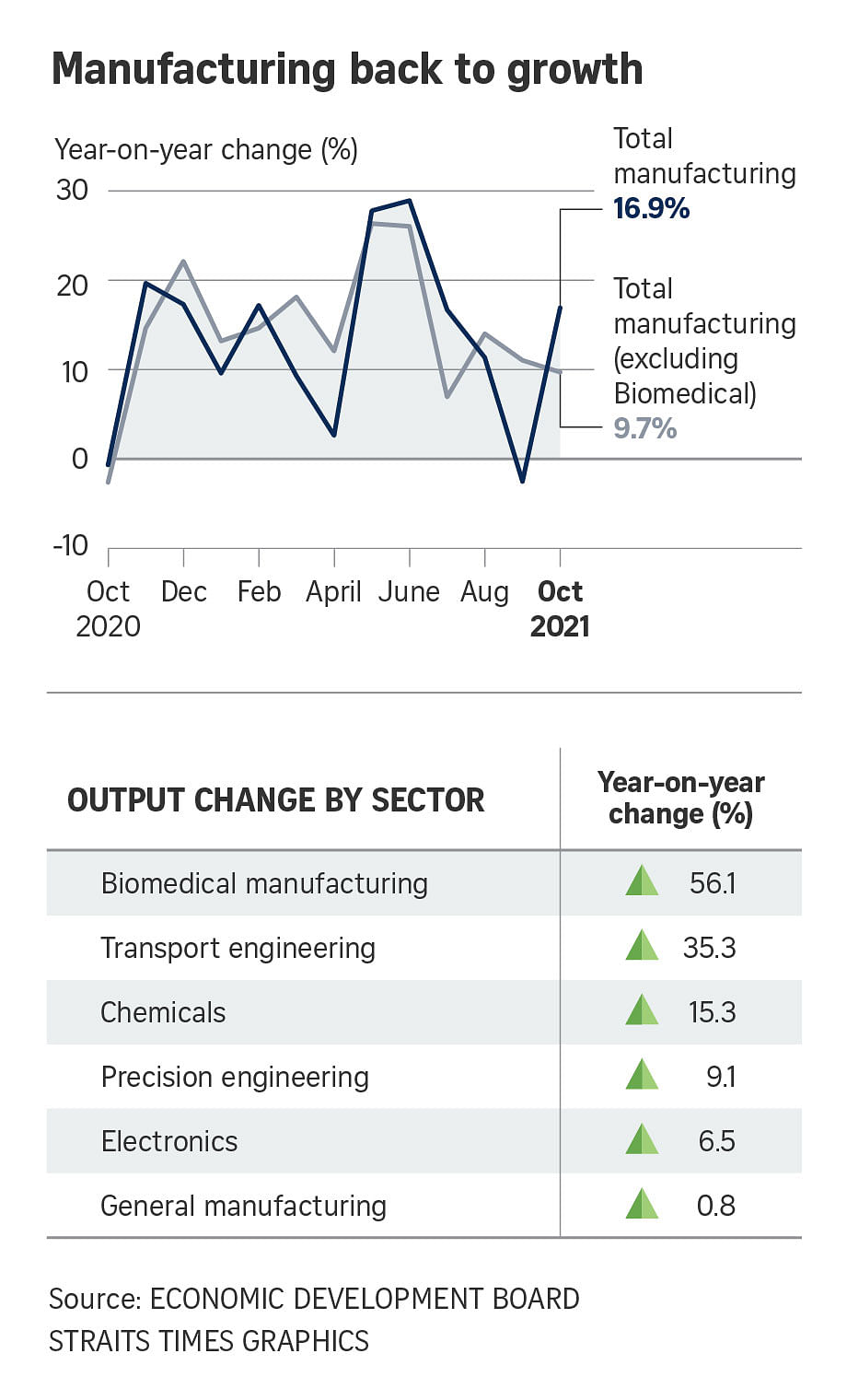SINGAPORE - Singapore's factory output returned to expansion in October as biomedical production rebounded and all manufacturing clusters posted growth that was partly boosted by a low-base effect.
Manufacturing output rose 16.9 per cent last month from a year ago, after a revised 2.2 per cent decline in September, according to data released by the Economic Development Board (EDB) on Friday (Nov 26).
Excluding the volatile biomedical manufacturing cluster, output grew 9.7 per cent in October.
UOB economist Barnabas Gan said the low-base effect does not detract from the stronger production momentum seen in the year to date, especially for industries that were previously hit by the pandemic.
"Most importantly, the growing demand for semiconductors and its related products underpinned Singapore's electronics and precision engineering clusters, and we continue to see these sectors supporting Singapore's overall manufacturing landscape," he said.
Singapore's key electronics sector saw output expand by 6.5 per cent year on year in October, slowing from the 7.2 per cent growth in September. All segments recorded a higher level of production.
For the year to October, electronics production grew 17.2 per cent compared with the same period last year.
Meanwhile, the biomedical cluster saw output surge 56.1 per cent, reversing a 35.9 per cent drop in the previous month. The pharmaceuticals segment expanded 93.4 per cent from a low production base last year, compared with the 46.2 per cent contraction in September.
But medical technology output fell 3 per cent amid lower demand for medical devices in some export markets.
Overall, biomedical manufacturing production grew 5.2 per cent in the first 10 months of this year.
Chemicals output increased by 15.3 per cent in October, with all segments recording output growth.
The petrochemicals segment grew 16.9 per cent and the petroleum segment expanded 15.7 per cent from a year ago, when production was low.
The other chemicals segment rose 11.7 per cent due to higher output in fragrances, while the specialities segment grew 9.3 per cent with increased production of mineral oil additives.
The chemicals cluster grew 10.1 per cent on a year-to-date basis, compared with the same period a year ago.
Precision engineering output also expanded, by 9.1 per cent, in October.
The cluster's growth was largely attributed to the machinery and systems segment, which expanded 19.6 per cent amid higher semiconductor equipment production to cater to the global semiconductor industry's strong capital investment.
However, the precision modules and components segment fell 11.2 per cent with lower output of optical products.
Overall, the precision engineering cluster grew 19.8 per cent in the first 10 months of 2021.
Maybank Kim Eng economists Chua Hak Bin and Lee Ju Ye expect manufacturing to remain resilient for the rest of the fourth quarter, with transport engineering improving as borders are relaxed and air travel recovers.
"Electronics and precision engineering will continue to expand on strong global chip demand," they added.
The transport engineering cluster's output expanded 35.3 per cent. The marine and offshore engineering segment rose 77.6 per cent with a higher level of work done in shipbuilding and repairing activities, compared with last year's low base.
The aerospace segment grew 26.9 per cent as demand for maintenance, repair and overhaul activities improved from a year ago, when there was widespread grounding of aircraft due to international travel restrictions.
Cumulatively, the transport engineering cluster grew 8.6 per cent year on year from January to October.

General manufacturing output inched up 0.8 per cent in October.
The miscellaneous industries segment grew 20.2 per cent from last year's low base, when demand for construction-related products was adversely affected by the Covid-19 pandemic.
However, the printing segment fell 8.2 per cent and the food, beverage and tobacco segment contracted 10.3 per cent due to plant maintenance shutdowns and lower production of milk products amid weaker export demand.


